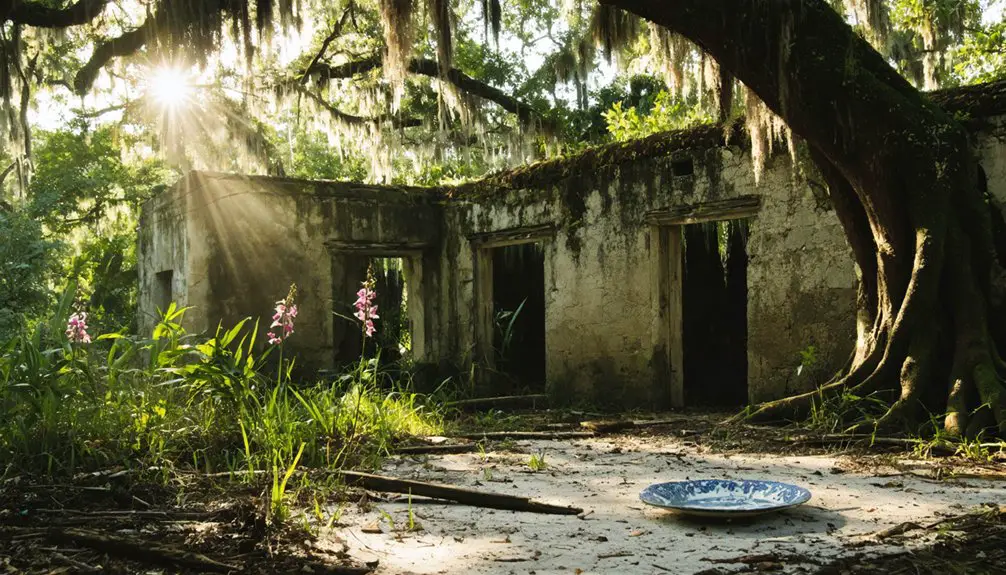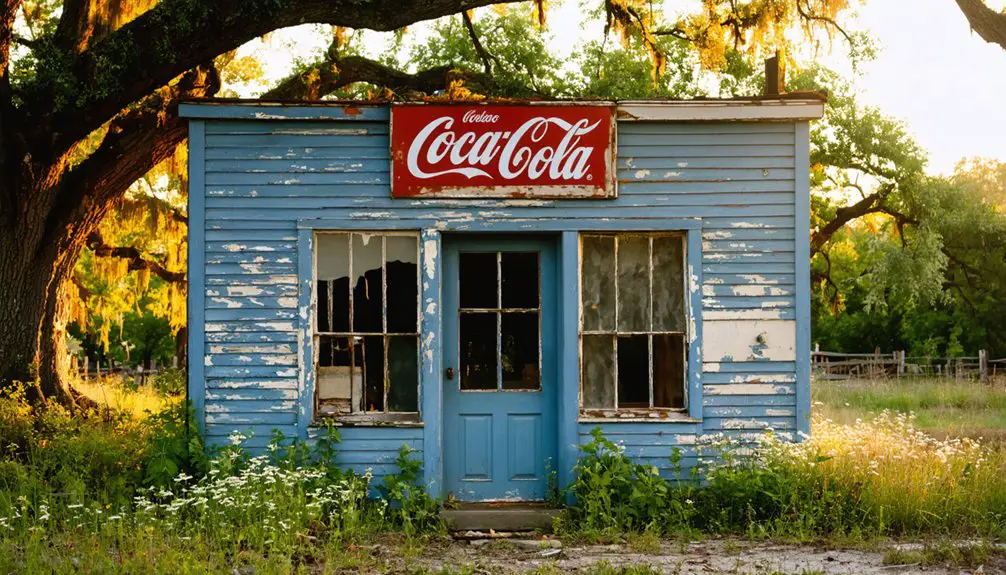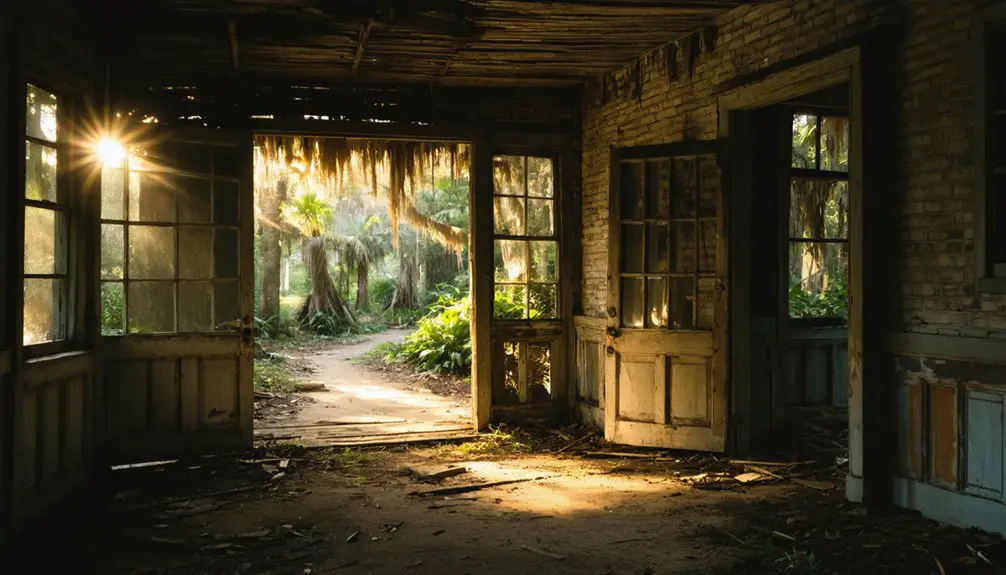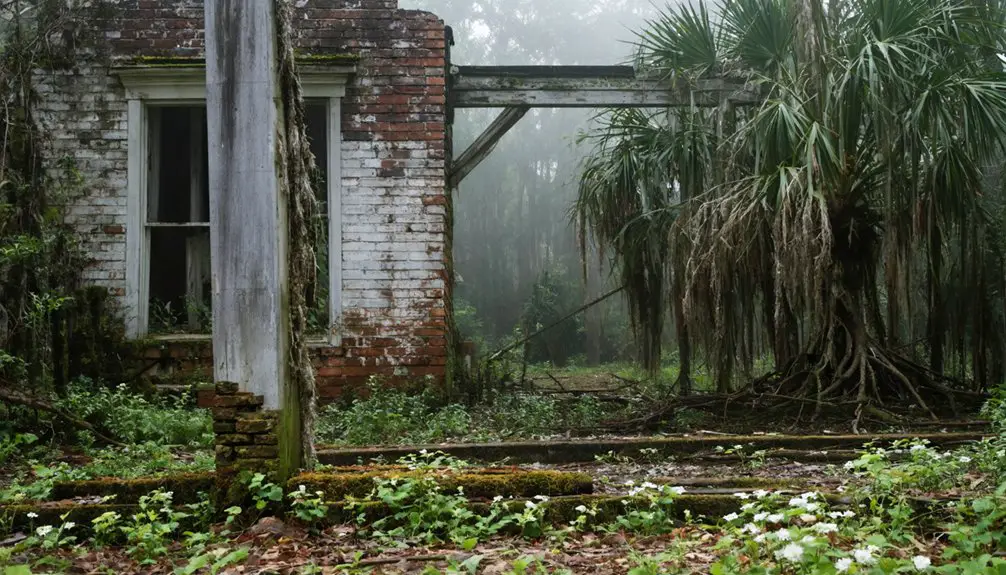You’ll find Ona, Florida as a semi-ghost town that emerged in the 1880s when Reason Cowart established a sawmill and country store at Cowart’s Corner. After thriving during the railroad era of the early 1900s, the town declined as timber resources depleted and highway transport replaced rail shipping. Today, this quiet rural community of fewer than 600 residents is best known for Solomon’s Castle, an eccentric architectural marvel that keeps Ona’s spirit alive through art and innovation.
Key Takeaways
- Ona declined after the 1930s when highway transport replaced rail shipping, leading to the closure of essential businesses and services.
- The town’s original economic centers – the sawmill, country store, and post office – all shut down following depletion of local forest resources.
- Population estimates range from 21 to 544 residents, with a high median age of 72 indicating an aging, diminishing community.
- Residents face long commutes averaging 26.6 minutes, suggesting limited local employment and economic opportunities within Ona.
- Solomon’s Castle remains the town’s main attraction, preserving Ona’s existence despite its ghost town status through tourism.
The Rise and Fall of Cowart’s Corner
As the 1880s dawned in rural Florida, Reason Cowart established what would become known as Cowart’s Corner by homesteading land at the intersection of present-day SR64A and CR661.
You’ll find that this pioneering settlement quickly developed its core community dynamics around a sawmill and country store, which served as both economic engines and social gathering spots. The establishment of a post office solidified the corner’s importance in regional commerce and communication. Examining historical maps from 1956 helps reveal the original layout and development of this frontier settlement.
As years passed, you’d have witnessed the settlement’s economic changes, from thriving timber operations to gradual decline.
The depletion of local forest resources and the rise of neighboring towns diminished Cowart’s Corner’s significance. Eventually, the sawmill closed, store operations ceased, and the post office shut down, marking the end of this once-vibrant frontier community.
Railroad Legacy and Economic Impact
While Florida’s first cross-state railroad connected Fernandina to Cedar Key in 1861, the rail lines that would transform Ona’s destiny came decades later.
The Seaboard Air Line acquired the rail network in 1900, bringing new investment and infrastructure to the region.
By 1911, the railroad’s influence turned Ona into a bustling hub, connecting western and central Florida through crucial shipping routes. You’d have found the Rainey Store at the heart of this economic transformation, serving as both a commercial center and gathering spot for the community.
The Charlotte Harbor and Northern railway passed through Ona on its nearly 100-mile route from Mulberry to Gasparilla Island.
The railroad’s impact extended beyond Ona, linking the region’s phosphate mines, timber operations, and agricultural enterprises to broader markets.
But when US-17 cut through nearby Wauchula in the 1930s, you’d have witnessed Ona’s gradual decline as highway transport eclipsed rail shipping.
Though the tracks’ prominence faded, they’d forever shaped Hardee County’s development patterns.
Solomon’s Castle: An Artistic Oasis
In the midst of Ona’s quiet landscape, you’ll find Solomon’s Castle, an extraordinary three-story structure that artist Howard Solomon began creating in the 1970s using discarded aluminum printing plates and found materials.
The castle’s distinctive features include 90 handcrafted stained-glass windows, reflective exterior walls, and an imaginative blend of towers and turrets rising from what was once swampland. A 65-foot Spanish galleon serves as the property’s unique restaurant, crafted entirely from recycled wood over a four-year period. The main galleries showcase an impressive collection of hundreds of sculptures crafted from everyday objects like nuts, bolts, and beer cans.
What started as Solomon’s personal creative vision has transformed into a cultural landmark that draws visitors to explore its galleries, restaurant, and bed and breakfast, offering a vibrant contrast to Ona’s ghost town status.
Visionary Behind The Castle
From his humble beginnings as a high school dropout in Rochester, New York, Howard Solomon emerged as the creative force behind one of Florida’s most distinctive architectural wonders.
His artistic inspiration took shape after moving south in his early twenties, where he mastered various construction trades in St. Petersburg and the Bahamas. When a customer recognized his true calling, telling him “You’re not a cabinet maker, you’re an artist,” Solomon’s path shifted toward creative construction.
In 1970, he purchased 40 acres of swampland near Horse Creek in Hardee County, Florida. Construction began in 1974 on the castle. A unique Boat in the Moat Restaurant housed in a 60-foot Portuguese galleon replica became a distinctive feature of the property.
There, you’ll find his masterpiece built largely by his own hands – a 12,000-square-foot castle adorned with recycled aluminum printing plates, featuring 80 stained-glass windows and whimsical sculptures crafted from automotive parts and found objects.
Architectural Design Features
Standing proudly in Hardee County’s swampland, Solomon’s Castle showcases an extraordinary blend of medieval architecture and modern industrial materials across its 12,000-square-foot expanse.
You’ll discover metal artistry at its finest, with recycled aluminum printing plates creating a reflective exterior that sparkles in the Florida sun. The whimsical architecture combines traditional castle elements like turrets, balconies, and a bell tower with contemporary flair. Created by The DaVinci of Debris, Howard Solomon transformed discarded materials into this architectural masterpiece. Visitors can explore the castle’s wonders through guided tours that reveal fascinating details about its construction and artistic elements.
Over 90 hand-crafted stained glass windows punctuate the metallic façade, filtering natural light in vibrant hues throughout the interior spaces.
A 65-foot Spanish galleon restaurant, “The Boat in the Moat,” adds maritime charm to the grounds. The castle’s courtyard features sculptural installations beneath oak trees, while inside, galleries display innovative artworks crafted from repurposed materials, making every corner an adventure in creative expression.
Cultural Impact Today
Solomon’s Castle emerged as a cultural phenomenon when Howard Solomon first welcomed curious locals onto his property in the early 1970s. Since then, this eccentric landmark has grown into a symbol of artistic freedom and creative expression in rural Florida.
You’ll find the castle’s cultural significance extends beyond its quirky exterior, as it’s become a beacon for sustainable art and personal storytelling. The site’s artistic legacy lives on through Solomon’s imaginative works, from the 90 handcrafted stained-glass windows to “The Menagerie” featuring sculptures made from 50,000 wire hangers. The castle’s dining establishment, The Boat in the Moat, provided essential income to maintain the property’s artistic vision.
Today, you can explore this folk art haven that’s hosted thousands of visitors, contributing to Hardee County’s identity as a hub of creative eccentricity. Under his daughter’s management, the castle continues inspiring new generations through its celebration of resourceful artistry and whimsical expression.
Pioneer Settlements and Seminole War Sites

Settlement of the Ona region began in 1849 with the establishment of the Kennedy-Darling Indian trading post along Paynes Creek, though its existence proved short-lived after an Indian attack destroyed it that same year.
Fort Chokonikla arose nearby to protect settlers, but disease forced its abandonment by 1850.
Pioneer resilience emerged as cattleman John Parker established a homestead near Ona on Troublesome Creek in 1855, marking a turning point in settlement.
Military fortifications expanded in 1856 with Fort Green and Fort Hartsuff, strengthening pioneer protection during the Third Seminole War.
You’ll find these historic sites scattered throughout the region, evidence to the area’s tumultuous beginnings.
While Fort Chokonikla‘s soldiers battled more with malaria than Indians, their presence helped secure the territory for future settlement.
African-American Heritage and Religious Life
Following the Civil War, African Americans began establishing communities throughout Southwest Florida, including Ona, despite facing persistent challenges of segregation and prejudice. Their community resilience shaped Ona’s development through:
- Early settlement by pioneering families like the Tillis family in 1869, who helped establish African-American presence in the region.
- Construction of crucial infrastructure including the Tamiami Trail and local docks.
- Development of religious institutions that preserved cultural narratives and served as community hubs.
- Agricultural work in farming and fruit picking that sustained economic growth.
Churches became central to African-American life in Ona, blending traditional African religions with Christianity.
Today, while African Americans make up 8.8% of Ona’s population, their historical contributions and cultural heritage remain an essential part of the town’s story.
Preserving Local History Through Museums

You’ll find two significant museums preserving Ona’s history: Solomon’s Castle, showcasing over 80 unique stained-glass windows and metal sculptures made from recycled materials, and the Cracker Trail Museum, housing more than 4,500 pioneer artifacts.
At Solomon’s Castle, you can tour galleries filled with artworks that transform everyday objects into masterpieces, while the castle’s architecture itself stands as a representation of creative preservation.
The Cracker Trail Museum’s collection of tools, citrus labels, and military memorabilia offers you direct connections to the region’s pioneer lifestyle, agricultural development, and wartime contributions.
Heritage Museums Showcase History
The heritage museums of Ona serve as essential guardians of local history, with Solomon’s Castle and the Cracker Trail Museum leading preservation efforts.
These institutions showcase the heritage significance of the region through immersive exhibits and authentic artifacts that you’ll find fascinating.
When you visit these museums, you’ll discover:
- Solomon’s Castle, built in 1972, featuring 80+ unique stained-glass windows and metal sculptures crafted from recycled materials
- The Cracker Trail Museum’s collection of 4,500+ artifacts, including pioneer tools and war memorabilia
- Living history displays at Cracker Country, complete with relocated historical buildings and period furnishings
- Guy LaBrie’s Seminole Indian artwork and the innovative “Boat in the Moat” restaurant
Through museum education programs, you’ll experience firsthand the rich cultural tapestry of early Florida pioneers, indigenous peoples, and settler communities.
Artifact Collection Essential Elements
Behind every compelling museum exhibit lies a complex system of artifact preservation and management. When you’re exploring Ona’s heritage collections, you’ll find items that have undergone rigorous artifact authentication processes, working with historians and collectors to verify each piece’s authenticity and provenance.
You’ll discover that preservation techniques are vital to maintaining these historical treasures. The museum’s climate-controlled storage areas protect artifacts from harmful environmental factors, while acid-free containers shield items from chemical damage.
Staff members use specialized handling protocols, including wearing gloves to prevent contamination from skin oils. Modern technology plays an essential role too – tracking systems monitor environmental conditions and maintain detailed records of each artifact’s location and condition, ensuring Ona’s historical pieces remain intact for future generations.
Modern Life in a Semi-Ghost Town
Modern life in Ona presents a stark portrait of rural decline, with population estimates ranging from as few as 21 to 544 residents in 2025.
Despite signs of urban decay, you’ll find glimpses of community resilience among the aging population, where the median age hovers around 72 years.
Daily life in this semi-ghost town revolves around:
- Long commutes averaging 26.6 minutes to work outside town
- Heavy reliance on personal vehicles, with households averaging 4 cars each
- A mainly English-speaking, U.S.-born population that’s 91% White
- Economic contrasts, where household incomes vary dramatically from zero to $93,670
You’ll encounter a tight-knit community of mostly elderly residents, maintaining their independence while adapting to limited local services and employment opportunities.
Historical Landmarks and Cultural Preservation

While many Florida ghost towns have lost their historical structures entirely, Ona’s cultural heritage remains vibrant through two remarkable landmarks: Solomon’s Castle and the Rainey Building.
You’ll find Solomon’s Castle, built in 1972 by sculptor Howard Solomon, showcasing unique artistic vision through towers, turrets, and sculptures crafted from industrial scraps.
It’s become a symbol of Ona’s cultural identity and continues drawing visitors to explore its creative legacy.
The 1880s Rainey Building, once Ona’s bustling general store and post office during the railroad boom, now stands preserved in Cracker Country museum.
Since its 1988 relocation, it’s fostered community engagement through living history exhibits and period displays.
Together, these landmarks keep Ona’s pioneer spirit alive, offering you a tangible connection to Florida’s rural past.
Frequently Asked Questions
What Is the Average Home Price in Present-Day Ona?
Amid swaying palms and rural charm, you’ll find Ona’s average home price ranging between $225,000-$275,000, though real estate listings span dramatically from $42,000 shacks to $2 million estates.
Are There Any Annual Festivals or Community Events in Ona?
You won’t find major annual festivals in Ona today. While there’s no official Ona Heritage festival or Ona Market events, you can enjoy nearby Hardee County’s Pioneer Festival each March.
How Safe Is Ona Compared to Other Florida Towns?
You’ll find much lower crime rates in Ona compared to Florida’s dangerous cities, with violent crime 51% below average and no murders reported. However, watch for rising property crimes affecting community safety.
What Job Opportunities Are Available for Residents in Ona?
You’ll find millions of possibilities in the local job market, with over 7,600 openings ranging from library work to customer service. You can explore state positions, nearby city employment, or local opportunities.
Does Ona Have Any Public Schools or Educational Facilities?
You’ll need to enroll your children in neighboring towns’ schools since Ona has no educational facilities. Instead, you can access public schools in North Wauchula, Zolfo Springs, or Bowling Green.
References
- https://www.pinterest.com/pin/ona-florida-wikipedia-the-free-encyclopedia–270356783855715316/
- https://www.visitflorida.com/travel-ideas/articles/hardee-county/
- https://www.youtube.com/watch?v=xtkvrDGjoxk
- https://www.youtube.com/watch?v=ov9YSsKtbDs
- https://en.wikipedia.org/wiki/Cracker_Country
- http://www.fphsonline.com/jrnlpdf/journal16.2.pdf
- https://eplanning.blm.gov/public_projects/nepa/92885/126252/153800/20060108_Cargill_01-08-06_Cultural_Resources_SFM_Hardee_(1).pdf
- https://pastmaps.com/explore/us/florida/hardee-county/ona
- https://freepages.rootsweb.com/~crackerbarrel/genealogy/Lily Union.html
- https://en.wikipedia.org/wiki/Florida_Railroad



